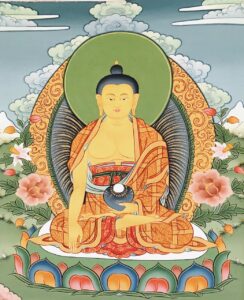 Shamatha & Vipashyana Meditation Practice
Shamatha & Vipashyana Meditation Practice
Shamatha: The Practice of Calm Abiding
Shamatha (Skt. śamatha; Tib. ཞི་གནས་, shyiné), or ‘calm abiding,’ is a cornerstone of Buddhist meditation. Often translated as ‘peacefully remaining’ or ‘tranquillity meditation,’ it is essential for cultivating a stable and serene mind.
In Buddhism, two central meditation practices are emphasized: calm abiding (shamatha) and clear seeing (vipashyana). Shamatha aims to calm the conceptual mind, while vipashyana, involving wisdom, provides clear insight beyond conceptual thought.
Shamatha meditation is classified into two types: Shamatha with an Object and Shamatha without an Object.
Shamatha with an Object: Practitioners focus the mind on physical objects such as enlightened forms or letters, or on positive thoughts or feelings, such as love, using mindfulness, vigilance, and carefulness. This practice involves avoiding distractions related to the six senses and balancing mental tautness and relaxation to allow the mind to settle without interference, thus gaining pliancy in mind.
Shamatha without an Object: This practice involves letting the mind remain calm, spacious, and at ease without focusing on a specific object. The mind is left as it is, without manipulation or alteration. Periodic application of mindfulness, vigilance, and carefulness is necessary to maintain this state.
 Vipashyana: The Practice of Profound Insight
Vipashyana: The Practice of Profound Insight
Vipashyana, known as ‘clear seeing’ or ‘insight’ meditation, is fundamental in Buddhist practice for directly and clearly understanding the ultimate truth. This practice dispels the darkness of ignorance, the root cause of all suffering. Known in Sanskrit as vipaśyanā and in Tibetan as lhaktong (ལྷག་མཐོང་), vipashyana complements shamatha, forming the two primary aspects of Buddhist meditation.
While shamatha focuses on calming and stabilizing the mind, it does not by itself uproot ignorance and delusion. Vipashyana, however, helps practitioners gain a deep understanding of the true nature of all phenomena, cultivating wisdom that discerns the true meaning of objects of knowledge.
The Ratnamegha Sutra beautifully encapsulates this duality: “Shamatha is the one-pointed concentration of the mind; Vipashyana is perfect discernment.”
Sources of Teaching
Our teachings on Shamatha draw from the instructions of ancient Indian and Tibetan Buddhist masters, as well as later masters such as Khenpo Pema Vajra, Mipham Rinpoche, Dudjom Rinpoche, and Kyentse Rinpoche.
For more information and detailed guidance on the practice of Shamatha and Vipashyana, please explore our resources or contact us directly.

